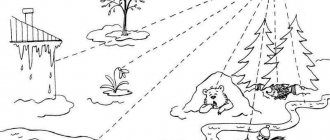Sound correction [l] at home
Speech disorders occur for various reasons. In the case where the child does not speak only one or two sounds, parents can try to correct the defect themselves.
Classes with a speech therapist will help correct any speech problems
How to teach a child to say the letter L hard
With dyslalia, children have problems only with sound pronunciation. Violations arise due to structural features of the articulatory apparatus or insufficient muscle preparation.
For the sound [l], the upper rise of the tip of the tongue is important. This is difficult to do with a short hyoid frenulum. Therefore, it must first be trimmed by a dentist. Only surgery will solve this problem.
It’s easy to check the ligament: you need to ask the child to touch the upper teeth with the tip of his tongue. Sonoras ([l], [r] and their soft pairs) appear by the age of five and until that time there is nothing to worry about. At three years old, the child’s articulatory apparatus is still developing.
Important! There is no need to rush and demand that children pronounce all sounds from an early age. Otherwise, you can provoke the development of a defect.
At home, you can try to correct the incorrect pronunciation of the sound [l] yourself. This is only allowed in the case of dyslalia. Sometimes this problem can be confused with dysarthria, which requires work with a speech therapist.
With dysarthria, the mobility of the muscles of the articulatory apparatus is impaired. A similar problem is expressed in hypertonicity or hypotonicity. Often the tongue of such a child is bunched up in the mouth or is too relaxed. It will be difficult for your baby to perform fine movements and switch from one position to another.
Correcting incorrect pronunciation may take up to one year. You need to work with your child every day - this will speed up the process. It is necessary to follow the sequence of stages and not rush.
Sound production
The mechanical method is often used in speech therapy. It requires a special probe in the form of a wire frame or a spatula. The child opens his mouth wide, pronounces “YYYYYY” in a drawn-out manner, and at this time the adult lifts his tongue with an instrument.
It is easier to teach a child to pronounce a sound from the interdental position. To do this, the preschooler is asked to bite the tip of the tongue and pronounce the sound [s] (YYYYYYY), and then gradually remove the tongue behind the upper teeth.
You can pronounce [l] in the interdental position immediately with syllables. Gradually we are moving away from this situation. Automation begins only with direct syllables: LA, LO, LY, LE.
Important! You cannot rush to move on to words, otherwise defective pronunciation will become entrenched.
Automation of sound C
Sound Automation
After the correct pronunciation has been worked out in forward and backward syllables, they move on to words. To facilitate perception, visual material is used in the form of pictures and special games. For example, a child is asked to show objects with the sound [l].
Syllables can be pronounced using a probe
It is difficult to teach a preschooler to exercise self-control. Therefore, you need to constantly work with him. It is enough to devote less than half an hour to work and the effect will not be long in coming.
Parents should understand that there is no method that will give quick results. Only constant training will help you consolidate correct pronunciation.
Songs and rhymes
To facilitate the automation process, different lexical material is used. Pure sayings and poetic forms are easier to remember and the child likes to reproduce them.
You can talk to a preschooler about different topics. This will make it easier for him to get used to the correct pronunciation.
Example of poems for sound automation [l]
The main condition for effective classes is the interest of the student. Therefore, everything is carried out in a playful way. The more varied the material, the better for the baby.
Tongue Twisters
The most difficult thing is to introduce sound into independent speech. To facilitate the process, tongue twisters using the sound [L] are used. They contain words that allow you to practice sound pronunciation in different positions.
For example, “There are pins at the Christmas tree”, “Will in the field”, “I went to Luka’s tray, Luka bought onions from the tray”, etc. Gradually, the child is asked to pronounce each tongue twister faster. Much attention is paid to correct pronunciation.
Articulation exercises
Learning to pronounce a sound correctly begins with articulatory gymnastics. Speech therapy exercises for quickly setting sound [l]:
- The wide tongue lies behind the lower teeth, the child pronounces “YYYYYYYY” in a drawn-out manner.
- Lick your upper lip with the tip of your tongue.
- Click your tongue.
- Open your mouth wide and run your tongue along the inside of your teeth.
- Run the tip of your tongue across the roof of your mouth.
The complex is performed every day. In order for a child to learn to pronounce a sound correctly, he must do all the exercises correctly. In this case, it is important to monitor the immobility of the jaw.
Articulation gymnastics is performed strictly in front of a mirror
After all the movements are easy to perform, move on to the next stage - producing a solid sound [l]. To do this, different techniques are used. It is impossible to say in advance which one will suit a particular child.
Recommendations for parents
Before moving on to exercises with the letter L, adults need to learn a number of simple rules that will make classes easy and spending time with your child enjoyable:
- Speak as equals. Don't try to make things easier by babying, you'll only make things worse. Pronounce all words correctly - this is an extremely important condition.
- Answer questions. If your child doesn’t understand something, stop and explain in more detail. This way your baby will feel strong support, and you will gain his full trust.
- Turn activities into games. Children learn information well through play. It is important that the exercises evoke a positive emotional response in the baby. Make up fairy tales and arrange unusual adventures. Under such conditions, the child will begin to pronounce the sound L reflexively.
- Exercise shouldn't be a punishment. In this way, you will discourage your child from wanting not only to study, but also to communicate with adults.
- Maintain regularity. Conduct classes systematically, at a time that is comfortable for you and your child. The ideal option is exercise for 5-10 minutes 3-4 times a day.
By following these simple recommendations, your child will quickly learn to pronounce the letter L at home.
The feasibility of speech therapy classes
Some parents do not think about how to teach their child to say the letter L. They do not consider the defect to be something serious, but in adult life it will become the basis of complexes and worries.
Important! It is better to correct speech disorders in preschool age, then the process will take a little time.
Games for children 5 years old for speech development and advice for parents
If parents do not know how to correctly teach their child to pronounce the letters L and R, then they should contact a specialist. A speech therapist will be able to correct this problem and develop the desired pronunciation.
How many lessons does it take to produce sound [l]
It is impossible to say with certainty how many lessons will be required to eliminate the defect. Sometimes sound production takes one session, in other situations it will take more than 30-40 meetings.
It all depends on the characteristics of the child, his motivation and the interest of the parents. Learning to pronounce the sound [l] is not so easy, since a preschooler gets used to a certain stereotype. Due to their age, it is still difficult for children to perceive learning activities.
How does an individual sound production lesson work [l]
The speech therapist performs sound production only after the student performs articulatory gymnastics well. The complex is performed strictly in front of a mirror. Afterwards they do breathing exercises and perform speech hearing tasks.
How does an individual lesson on sound automation work [l]
The speech therapist conducts individual lessons on automating the sound [l] only after calling an isolated pronunciation. At such lessons, the specialist develops the lexical and grammatical structure of speech, phonetic and phonemic hearing.
To do this, use different games and simulators. Modern speech therapists use computer games. Parents are required to participate in the process and carry out the specialist’s tasks at home.
Important! The duration of the lesson for preschool age is approximately 25 minutes. Physical minutes are required to switch activities.
Caution: physiological dyslalia
But by the age of four you need to be on your guard: the time for correct speech comes, and the baby simply does not know how to pronounce some sounds. And if you leave it to chance, and don’t teach him to speak correctly in time, you can make your child the subject of mockery and ridicule for the rest of his life. And he will probably have problems with spelling. Along with the difficult consonant “R”, many children do not know how to pronounce the letter “L”.
This speech defect is called physiological dyslalia in speech therapy and is quite common among children from four to six years old.
Types of pronunciation disorders
Over time, many people themselves can learn to speak correctly. This is how a child can distort the letter "L".
- The baby does not hear this sound and completely misses it: instead of “ruler” he says “frost”.
- “L” is replaced by the sound “U” or “V”: “spoon” - “oozhka”; "Larissa" - "Varisa". At the same time, children try to pronounce “L” not with the tip of their tongue, but with their lips
- Instead of “L” it is pronounced “Y”: “hammer” - “myotok”
- The child confuses the hard and soft letter “L”.
Before contacting a speech therapist, it is useful for parents to become familiar with the rules of pronunciation of the sound L and teach them to their child. Perhaps after home lessons he will begin to say this sound correctly.
Poems about the letter L
The alphabet will continue with our Letter L - forest hut.
ΛΛΛΛΛ
L looks like a stepladder And the roof of a house too. Light Leaf Flew through the Forest, Didn’t Want to Land.
S. Ivanov
ΛΛΛΛΛ
The letter L came to visit us, Larisa found it for us, gave it to Lena, Alla, and did you recognize it?
ΛΛΛΛΛ
The letter L is such a sleepyhead, Yes, a well-known style, Everyone knows the word “laziness”, Walks, wanders, like a shadow, Puts sleep on people, Yes, closes everyone’s eyes.
ΛΛΛΛΛ
The frog healer is known in the forest; the frog treated the fox with a bow, and covered its paw with a rag. The elk was treated with lily leaf.
R. Gorenburgova
Tale about the letter L
Little Fox and Little Frog
In the forest, in a large puddle, there lived a little frog who really loved to sculpt from clay. He crawls out of the puddle, picks up some clay and sits there sculpting. At first he only made flat cakes. Then he started making koloboks and lemons. Then he made an elephant and after that a lion on skis and a horse in a boat.
The animals looked, laughed and affectionately stroked the frog on the back. Only one little fox (was he jealous, or what?) came, broke everything, and even teased:
- Greenest of all is the big-eyed frog!
And this continued until the little fox grew up. One day he came to a puddle, sat down next to the frog, watched for a long time as he sculpted, and said sadly:
- I used to sculpt too, but I just couldn’t do anything... - Nothing! - said the frog. - Don't be upset! But you dig the most cunning holes.
(G. Yudin)
Improving speech hearing
Correct formulation of L is impossible without comprehensive development. To improve speech hearing, the following exercises are recommended:
- Pronouncing words at different volumes - from quiet to loud and back again. You can show toys, explaining that the little one speaks quietly, and the big one speaks loudly, then vice versa;
- Reading fairy tales in roles with voice acting of characters in different voices - loud and quiet, low and high;
- Showing pictures and deliberate mistakes in naming words. The child must “catch” you and identify incorrectly designated words;
- Working with pictures that show several words that are similar in pronunciation. The baby must name them correctly. For example, “bow-luk-meadow”.
Do your workouts regularly, supplementing them with games to music. An important element of success is discipline. Teach your child not to miss classes and to work persistently. Think about the motivation - talk about the joys of communication with correct speech. Be patient and tactful, do not criticize for mistakes and failures. Everything will work out!
Breathing exercises
Exercises for setting L are combined with breathing techniques to enhance the effect:
- Inhale quickly and exhale smoothly;
- Blow on the turntable for as long as possible;
- Stop the running horse: take a breath, relax your lips, exhale the air to make the sound “prr”;
- Inflate the “ball”: lying on your back while inhaling, strongly protrude your stomach, while exhaling, “deflate”.
You can play a guessing game - ask your child, with his eyes closed, to guess fruits or other objects by smell. For correct setting, all tasks are performed while inhaling.
Reasons for violations
There are many possible provoking factors:
- Breathing disorders during speech, for example, with a pathology such as a decrease in lung volume or weakness of the respiratory muscles;
- Problems with speech hearing (the child does not perceive speech well);
- Weakness of facial expressions and tongue muscles;
- Incorrect structure of the frenulum under the tongue.
Often, birth injuries and delayed mental and motor development in infancy and preschool age lead to problems in articulation. It is important to contact a speech therapist in a timely manner to correct the situation.
The stages of setting the sound L are preparation, direct correction and consolidation. It is important to do everything step by step, practicing each step.
Correct articulation of the L sound
- The lips should be stretched into a smile and clenched teeth should be shown: this is necessary so that the hard sound “L” does not turn into “V” or soften.
- The tip of the tongue can occupy the following positions: it presses on the upper teeth; it can be pressed against the upper alveoli; it can rest against the gap between the teeth.
- The air is pushed out under pressure through the holes on the sides of the tongue.
- It is important that the tongue does not rest against the sides of the teeth, allowing air to pass through.
Classes should be conducted in this order
Before you start practicing, you need to practice pronouncing this sound according to all the rules in front of a mirror. It is likely that the child received a speech defect as a result of the incorrect pronunciation of the letter “L” by someone in the family.
Articulation gymnastics
The set of exercises for setting includes tasks similar to those in the preparatory stage, but they are somewhat more complicated:
- "Window". The mouth is wide open, the teeth are slightly parted, and the tongue lies at the bottom of the mouth. The jaws are motionless and slightly tense. The position is held for up to 5 – 10 seconds;
- "Ladle". The tongue sticks out, and its tip bends like a ladle. The middle part of the tongue does not touch the upper teeth. The position is fixed for a few seconds, then the tongue relaxes and retracts into the mouth. You need to do several repetitions;
- "Panicle". The curved and tense tip of the tongue needs to be moved across the palate at different paces, gradually connecting the voice. The jaw does not move, the teeth are visible;
- "Cup". We make the tongue a “broom”, as in the previous exercise, reaching the palate with the curved tip at the alveoli. The lips take on an oval shape;
- "Harmonic". The tongue is applied to the palate, after which the mouth must be opened and closed, stretching the ligaments well.
The exercises are aimed at increasing the motor activity of the tongue, practicing the desired position, increasing tone and improving the elasticity of the hyoid ligament.










